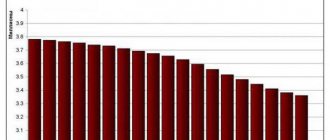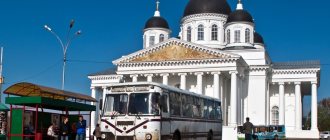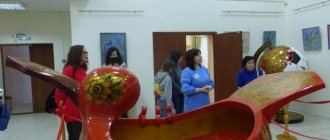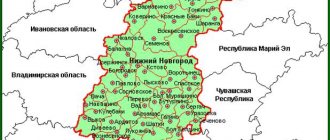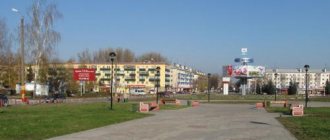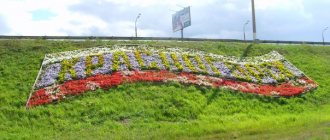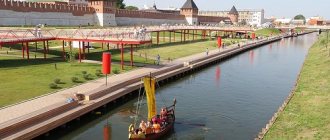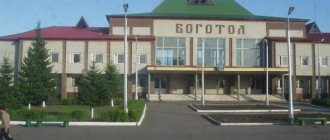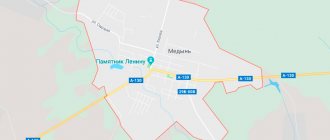This toponym has other meanings, see Volodarsky district.
| district[1] / municipal district[2] | |
| Volodarsky district | |
| Flag | Coat of arms |
- (1,82 %)
Volodarsky district
- administrative-territorial entity (district) and municipal entity of the same name (municipal district) as part of the Nizhny Novgorod region of Russia.
The administrative center is the city of Volodarsk.
Population
| Population | ||||||||
| 1989[6] | 2002[7] | 2008[8] | 2009[8] | 2010[7] | 2011[8] | 2012[9] | 2013[10] | 2014[11] |
| 49 119 | ↗59 498 | ↘56 169 | ↘56 041 | ↗58 807 | ↘58 768 | ↗58 778 | ↗58 783 | ↘58 499 |
| 2015[12] | 2016[13] | 2017[14] | 2018[15] | 2019[16] | 2020[4] | |||
| ↘58 169 | ↘57 993 | ↗58 043 | ↗58 186 | ↘57 954 | ↗57 962 | |||
Employment
| The information in this article or some sections of it is out of date. You can help the project by updating it and then removing this template. |
The working-age population is 35,000 people. Pensioners - 13 thousand people. As of September 1, 2003, in terms of unemployment, the Volodarsky district is in 17th place among other districts of the Nizhny Novgorod region, in terms of wage arrears per capita and overdue accounts payable - in 1st place.
Religious composition of the population
The Orthodox religion predominates in the area, including the Old Believers (Fedoseevskaya community[17]). There are churches in Volodarsk, in the villages of Ilyinogorsk, Mulino, Smolino, Central, Reshetikha, Krasnaya Gorka, Novosmolinsky, Yuganets, Frolishchi (Holy Dormition Monastery of Florishcheva Pustyn), the villages of Starkov, Myachkov, an Old Believer prayer house in Volodarsk, a mosque in the village of Krasnaya Slide.
History of Dzerzhinsk.
Dzerzhinsk (Nizhny Novgorod region) is the second largest and most populous city in the region, located near Nizhny Novgorod, about 30 km. It is the center of the administrative unit of the Nizhny Novgorod region, the urban district - the city of Dzerzhinsk. Named in 1929 after the Russian revolutionary and chairman of the All-Russian Extraordinary Commission F. E. Dzerzhinsky. (The commission had very great rights and opportunities, the ancestor of the Soviet KGB). The city is located on the banks of the Oka River, almost in the center of the European part of Russia, and is connected to the country by railway and federal highways Moscow - Nizhny Novgorod and Kazan - Nizhny Novgorod. The international airport is located almost at the same distance from Dzerzhinsk as from the regional center. Dzerzhinsk is an industrial city with a good personnel reserve and a high energy supply. All these factors make it attractive for business, and serious investors have paid attention to the features and potential of Dzerzhinsk. 2006 was already a turning point for the city, and since 2007, solid investments began to flow into the industry of Dzerzhinsk. History of Dzerzhinsk.
In the place where the city of Dzerzhinsk is located, people have settled since ancient times; in its vicinity, sites of ancient people living on the banks of the Oka 3500 years ago were found. In the 17th and 18th centuries there were small villages here - Kolodkino, Babino, Chernoye and others. Among them is the small settlement of Rastyapino. The area was called by the name of the Chernaya river flowing here - Chernorechye, and the volost was called Chernoretskaya. Chernorechye was the name of the area on the left bank of the Oka, upstream from Nizhny Novgorod. The water in the river was black, since the soil along which the river bed flowed had a high peat content. At the end of the 40s, due to intensive peat extraction and high water consumption for the needs of factories being built here, the river dried up. The village of Rastyapino was first mentioned in documents in 1606, when the village was transferred to the Dudin monastery. In 1752, the lands in the vicinity of the village of Chernoye were granted to the Trinity-Sergius Lavra. “Pyra, the village of Chernoe, the villages next to it: Rastyapino, Babushkino, Babino, Kolodkino, Yuryevets, Igumnovo, the villages of Dubenki and Zhelnino.”
In 1915, a mineral acids plant was built (now Korund LLC).
Kusakin Alexey Fedorovich
In 1916, the Okhtinsky powder plant was evacuated from Petrograd to Rastyapino, away from the hostile western borders. In the shortest possible time, production began working in a new place - in October 1917, products were already being produced. (now - FKP "Plant named after Ya. M. Sverdlov"). In those distant years, the Chernorechensk people, who from time immemorial lived on forestry and river trades, accepted the appearance of unusual enterprises with obvious displeasure. At the mineral acids plant, which was later renamed the Chernorechensky chemical plant, most of the workers were refugees and prisoners of war. And at the former Okhtinsky there are workers and specialists who arrived with the plant. They settled near the enterprises themselves, as best they could and where they could. Until 1927, the history of the city of Dzerzhinsk developed near the village of Rastyapino. In 1929, construction of the central square of the city began, on June 22, 1929, the workers' village of Rastyapino, at numerous requests from residents, was given a new name, the workers' village of Dzerzhinsk. A.F. Kusakin . It is his projects that determine the identity of the city to this day. These include residential buildings, ensembles of squares, and avenues. The architectural symbol of Dzerzhinsk became a house with a spire on Chkalov Avenue. In 1930, the workers' settlement received city status.
Years of the Great Patriotic War.
Life in the rear during wartime was strictly regulated. Thus, the regional committee of the CPSU(b) approved what holidays and events should be celebrated and controlled the content of all articles in the city newspaper. Business correspondence was subject to strict censorship and private letters were subject to mandatory inspection. All radios were confiscated from the townspeople. However, this happened in all rear cities of the country. The main concern of the city authorities was to provide conditions for the normal operation of twelve military hospitals, to accommodate a considerable number of evacuated enterprises and their workers, to supply the city with fuel for the winter, to prevent epidemics and mass diseases, and to strictly control the distribution of food cards. The 1291st Anti-Aircraft Artillery Regiment was responsible for the air defense of Dzerzhinsk during the war. But the city escaped bombing, although Gorky was repeatedly attacked by enemy bomber aircraft. The German pilots, lying just to the west of Dzerzhinsk, did not seem to notice. There were rumors that the owners of large chemical concerns in Germany specifically agreed with Hitler to preserve the entire Dzerzhinsky chemical complex intact in order to use it after the victory. And perhaps this brought Germany’s defeat in the war closer. With the outbreak of war, all Dzerzhinsk enterprises quickly switched to working in wartime mode. It was necessary to significantly increase production output at existing facilities and create new production facilities focused on the needs of the front. And the Dzerzhinsky residents managed to achieve this - during the war years, local factories increased their gross output compared to the pre-war, 1940, three and a half times. Already in 1941, the production of unique products began, which were not produced anywhere except Dzerzhinsk in the USSR. In June 1941, at the Chernorechensky chemical plant, a plant was launched for the production of self-igniting liquid “KS”, which turned out to be super effective in the fight against enemy tanks. From films and books about the war, many remember bottles with the famous “Molotov cocktail”, from which German equipment literally burned with a blue flame. Dzerzhinsk sent explosives, combustible mixtures, Katyusha shells, and anti-tank mines to the front. Up to 3 million shells, mines, and bombs were produced per month. The heroism of the people who worked in such conditions was no less than the heroism of the front-line soldiers. It is not for nothing that more than five hundred Dzerzhin residents were awarded high state awards during the war years. The cost of victory over fascism turned out to be very high, and the Dzerzhintsy made a significant contribution to this victory. Twenty-eight thousand Dzerzhin residents fought on the fronts of the Great Patriotic War, about ten thousand of them died and went missing. More than nine thousand Dzerzhin residents were awarded military orders and medals. Twenty-six of them were awarded the highest award - the title of Hero of the Soviet Union. Six Heroes died at the front. The names of three of them are on the streets of the city - Galkin, Samokhvalov, Sitnov. A fair share of the burden of labor in the rear fell on the shoulders of women and teenagers. Many of them did not have the strength to live to see the Victory. This and they deserved the Order of the Red Banner of Labor, which Dzerzhinsk was awarded in the year of its fiftieth anniversary, including for “contribution to ensuring Victory in the Great Patriotic War.”
Post-war period.
During the fifteen post-war years, the pace of industrial and housing construction in Dzerzhinsk was truly impressive. During this time, a chemical engineering plant (now Khimmash), a bakery plant, and a clothing factory began to gain momentum. Large-scale construction of new production facilities at large chemical enterprises made it possible to increase the output of industrial products eight times compared to the pre-war 1940. New apartment buildings also appeared (two billion rubles were invested in housing construction after the war), the first drama theater building was built in 1948. According to the All-Union Population Census in 1959, there were 164,337 residents in Dzerzhinsk. The rapid increase in the number of city residents required appropriate socio-cultural support for their lives. Therefore, in those same years, a new railway station, a new music school building were built in the city, and two new secondary specialized educational institutions were opened: a chemical-mechanical technical school and a music school. In 1959, the magnificent Palace of Culture of Chemists opened its doors to the residents of Dzerzhinsk. A developed system of vocational, secondary and higher education has been created in Dzerzhinsk. The city has three vocational schools, eight secondary vocational educational institutions - a technical college, a music college, a chemical technical school named after the Red Army, a polytechnic technical school, an industrial-commercial technical school, a pedagogical college, a comprehensive college of computer science, and a technical school of economics. Higher education can be obtained at the Modern Humanitarian Institute, Dzerzhinsky Polytechnic Institute, and the Institute of Modern Economics. The Volga-Vyatka Academy of Public Administration recruits applicants here; the St. Petersburg Institute of Foreign Economic Relations, Economics and Law and the Nizhny Novgorod State University named after V.I. Lobachevsky. All these educational institutions continue to train specialists for the Dzerzhinsk industry.
Administrative and municipal structure
The Volodarsky district, within the administrative-territorial structure of the region, includes 11 administrative-territorial entities, including 1 city of regional significance, 6 workers' villages and 4 village councils[5][18][19].
The Volodarsky municipal district, within the framework of the organization of local self-government, includes, respectively, 11 municipalities, including 7 urban settlements and 4 rural settlements[20].
| № | Administrative-territorial (municipal) entity | Administrative center | Number of settlements | Population (persons) | Area (km²) |
| 1 | Volodarsk city | Volodarsk city | 1 | ↘9898[4] | 88,64[3] |
| 2 | working village of Ilyinogorsk | working village of Ilyinogorsk | 1 | ↘7142[4] | 17,25[3] |
| 3 | working village of Reshetikha | working village of Reshetikha | 1 | ↘6620[4] | 31,36[3] |
| 4 | working village of Smolino | working village of Smolino | 1 | ↘2422[4] | 156,97[3] |
| 5 | working village of Frolishchi | working village of Frolishchi | 1 | ↘1396[4] | 134,88[3] |
| 6 | working village of Central | working village of Central | 2 | ↗3197[4] | 78,69[3] |
| 7 | working village Yuganets | working village Yuganets | 1 | ↘2705[4] | 49,00[3] |
| 8 | Zolinsky village council | Novosmolinsky village | 4 | ↗5639[4] | 39,90[3] |
| 9 | Ilyinsky village council | Ilyino village | 8 | ↗2991[4] | 86,84[3] |
| 10 | village council Krasnaya Gorka | Krasnaya Gorka village | 7 | ↗1460[4] | 45,32[3] |
| 11 | Mulinsky village council | Mulino village | 5 | ↗14 492[4] | 320,80[3] |
Initially, until 2009, the territory of the Volodarsky district consisted of 1 city of regional significance, 6 workers’ settlements and 5 village councils. As part of the organization of local self-government in 2006-2009. 7 urban and 5 rural settlements were formed, respectively.
In 2009, the Myachkovsky Village Council, which was included in the Ilyinsky Village Council, was abolished[21].
Settlements
There are 32 settlements in the Volodarsky district.
| List of settlements in the region | ||||
| № | Locality | Type | Population | Administrative-territorial (municipal) entity |
| 1 | Volodarsk | city | ↘9898[4] | Volodarsk city |
| 2 | Gladkovo | village | ↗91[7] | Zolinsky village council |
| 3 | Golyshevo | village | ↗221[7] | village council Krasnaya Gorka |
| 4 | Virgo | village | →14[7] | Mulinsky village council |
| 5 | Dubki | village | ↘37[7] | village council Krasnaya Gorka |
| 6 | Zolino | village | ↘450[7] | Zolinsky village council |
| 7 | Ilyina Gora | village | ↗275[7] | Ilyinsky village council |
| 8 | Ilyino | village | ↗2242[7] | Ilyinsky village council |
| 9 | Ilyinogorsk | workers' village | ↘7142[4] | working village of Ilyinogorsk |
| 10 | Engineering | village | ↘242[4] | working village of Central |
| 11 | Red hill | village | ↗624[10] | village council Krasnaya Gorka |
| 12 | Red Drummers | village | ↘4[7] | Mulinsky village council |
| 13 | Mulino | village | ↘91[7] | Mulinsky village council |
| 14 | Mulino | village | ↗13 008[7] | Mulinsky village council |
| 15 | Myachkovo | village | ↗207[7] | Ilyinsky village council |
| 16 | Novosmolinsky | village | ↗5587[7] | Zolinsky village council |
| 17 | Detour | village | ↘28[7] | Ilyinsky village council |
| 18 | Okhlopkovo | village | ↘40[7] | village council Krasnaya Gorka |
| 19 | Reshetikha | workers' village | ↘6620[4] | working village of Reshetikha |
| 20 | Sedelnikovo | village | ↗118[7] | Ilyinsky village council |
| 21 | Smolino | workers' village | ↘2422[4] | working village of Smolino |
| 22 | Solovyovo | village | ↗25[7] | Ilyinsky village council |
| 23 | Old Seimas | village | 5[7] | village council Krasnaya Gorka |
| 24 | Starkovo | village | ↗82[7] | Mulinsky village council |
| 25 | Talashmanovo | village | ↗113[7] | Zolinsky village council |
| 26 | Frolishchi | workers' village | ↘1396[4] | working village of Frolishchi |
| 27 | Central | workers' village | ↗2955[4] | working village of Central |
| 28 | Chernukha | village | ↘30[7] | village council Krasnaya Gorka |
| 29 | Chicherevo | village | ↗77[7] | Ilyinsky village council |
| 30 | Shchelapino | village | ↗22[7] | Ilyinsky village council |
| 31 | Shchelkanovo | village | ↗221[7] | village council Krasnaya Gorka |
| 32 | Yuganets | workers' village | ↘2705[4] | working village Yuganets |
Economy of the region
Industry
There are 12 manufacturing enterprises operating in the district, the main ones being:
- LLC "Bugrovskie mills" - flour production;
- LLC "Flour Mill "Volodarsky" - production of flour, semolina;
- LLC - production of zinc white, zinc oxide.
The volume of shipped goods of own production in manufacturing industries in 2022 amounted to 4.6 billion rubles.
Agriculture
The agricultural sector is represented by the following enterprises:
- OJSC Agro - production of eggs, poultry meat, canned poultry;
- LLC "Mulinskoe fish farm" - cultivation of sturgeon fish;
- LLC "Sea of Milk";
- JSC SIP "Agro-Seima".
In total, there are 4 agricultural enterprises and 6 peasant (farm) enterprises in agriculture. The volume of shipped goods of own production in agriculture in 2022 amounted to 3.0 billion rubles.
Transport
Well developed by trains and buses to Dzerzhinsk and Mulino, Novosmolino.
Connection
A new digital telephone exchange with 4,000 numbers was built in Volodarsk, and broadband access and PON technology is actively developing in the region.
Culture and education
Holy Dormition Monastery (Florishcheva Monastery).
Frolishchi, Volodarsky district https://sobory.ru/article/index.html?object=00900[] Educational institutions:
The number of children in preschool educational institutions is 214 people, the number of places in preschool institutions is 2779.
The number of preschool children from 0 to 1 year is 42,430 people, from 1 to 7 years - 873,250 people.
The total number of students in educational institutions is 6656 people. There are 15 secondary schools in the area, including 3 in Volodarsk.
Also in the Volodarsky district there are:
- 5 adolescent rehabilitation centers (day care);
- 19 preschool institutions.
Culture and sports:
Florishcheva Pustyn
The area has:
- 1 museum center;
- 3 sports and health centers;
- 4 stadiums;
- 4 art schools;
- 6 art schools;
- 13 music schools;
- 13 sports complexes;
- 14 libraries;
- 26 public organizations, of which 17 are trade unions;
- 35 club institutions;
- youth, “Sambo” and others;
- society of hunters and fishermen.
The district newspaper “Znamya” is published in the region, periodically - once a week, 52 editions per year.
Historical reference
Railway - the beginning of development
The impetus for the development of Chernorechye was the construction of the railway. In the 60s of the 19th century, the Chernoe stop appeared. At the same time, the first enterprises began work here - first an alabaster-gypsum plant, then a rope factory. By 1900, there were 13 enterprises in Chernorechye, employing 1,700 workers.
Domestic chemistry began here
The year was 1915. The First World War required more and more ammunition, chemical protective equipment, and medicines, the production of which cannot be done without chemicals. But all chemical enterprises operating in Russia in those years were dependent on foreign companies. It was then that, not far from the Rastyapino station (this is how the Chernoye stop was renamed and the village received the same name), a mineral acids plant (now Korund) was founded, and a gunpowder plant from Petrograd was relocated here (now the Federal State Unitary Enterprise "Plant im.Ya" M. Sverdlov").
Construction of a socialist city
In the 20s, using the existing potential, the Soviet government began active reconstruction and expansion of existing factories and the construction of new workshops. Labor was needed, so the population of the village of Rastyapino grew 4 times in 6 years - from 3.5 thousand people. Up to 14.5 thousand (1929). Most of the residents were employed in industrial enterprises.
Industrialization
Industrialization began in Soviet Russia. Large-scale construction projects are spread across the country. On the site of the village of Rastyapino, Nizhny Novgorod Territory, it was decided to build a new social city. City of the chemical industry. Construction began in 1929. In the same year, the village received a new name - Dzerzhinsk. And on March 30, 1930, the Presidium of the All-Russian Central Executive Committee, by its resolution, changed the status of Dzerzhinsk to a city - this date is considered his birthday. In the first years of its life, the city faced an acute transport problem. This was due to the great distance of industrial enterprises from the city. The problem was solved in 1933, when the first tram was launched for the November 7 holiday. The end of the 30s was marked by the entry into operation of new large ones (now OJSC Sintez), Zavodstroy (now OJSC Kaprolaktam), Zarya, and Rulon (OJSC Plexiglas). In 1939, the Igumnovskaya CHPP began operating. By 1941, the socialist city of Dzerzhinsk played the role of a large industrial center not only of the Nizhny Novgorod region, but of the entire country.
Years of the Great Patriotic War
The Great Patriotic War marked the stage of intensive development of the chemical industry in Dzerzhinsk. The main task of the city during the hard times of war was to provide the Soviet army with ammunition. There were not enough raw materials, equipment, and labor. However, the war made strict demands. The city's industry increased production by 3.5 times compared to peacetime. Dzerzhinsk sent explosives, combustible mixtures, Katyusha shells, and anti-tank mines to the front. For their selfless work, about 28 thousand Dzerzhin residents - home front workers - were awarded orders and medals, the Korund enterprises and the plant named after. Ya.M.Sverdlova were awarded orders. About 30 thousand Dzerzhin residents left our city to go to the front and fought bravely. A third of them did not return from the war. 28 of our fellow countrymen were awarded the title of Hero of the Soviet Union. Dzerzhinsk, located deep in the rear, became a center for the treatment and rehabilitation of wounded soldiers. The best buildings in the city were given to evacuation hospitals. In memory of the Dzerzhin residents who fought for Victory at the front and in the rear, the Eternal Flame burns on Heroes Square.
- Dzerzhintsy - holders of the Order of Glory, 3 degrees
- Dzerzhintsy - veterans of the Great Patriotic War - part 1
- Dzerzhintsy - veterans of the Great Patriotic War - part 2
- Veterans - employees of Dzerzhinsk enterprises
Information about Dzerzhinsk residents - WWII veterans, holders of the Order of Glory is provided from the book by N. Gorbunov “They Defended the Motherland”
Industrial enterprises of Dzerzhinsk in the years
Great Patriotic War 1941–1945: contribution to the Victory
(historical reference)
The certificate was developed by the Committee for Archives of the Nizhny Novgorod Region
During the Great Patriotic War of 1941-1945. In the Gorky region, 13 chemical enterprises operated, the main of which were located in the city of Dzerzhinsk. Dzerzhin residents made a great contribution to the cause of Victory with their labor. From the very first days of the Great Patriotic War, the city was rebuilt under a military regime. Already in 1941, Dzerzhinsk became the center of the Soviet chemical industry: the share of the chemical industry in the Gorky region by the end of 1941 was 28.9%. At the same time, for caustic soda it reached 50%, for ethyl liquid - up to 70.7%, for sheet organic glass - up to 90%. It was to Dzerzhinsk that the People's Commissariat of the Chemical Industry of the USSR was evacuated at the beginning of the war.
The city hosted such large chemical plants as the Chernorechensky Chemical Plant named after M.I. Kalinin, plants named after Ya.M. Sverdlov, “Zarya”, “Oka”, “Plexiglas” (“Roll”), “Caprolactam”, “etc. The importance of the Dzerzhinsky chemical hub is evidenced by the fact that during the war years it produced up to 50% of explosives from the total quantity in the country and more than 150 million pieces were produced. ammunition.
Chernorechensky plant (plant named after M.I. Kalinin, now OJSC Korund)
Director during the war years - A.M. Klimakhin, 1940-1959.
Already in June 1941, the plant began operating a plant for the production of self-igniting liquid “KS”, which played an important role in the fight against enemy tanks. Subsequently, in the central laboratory of the plant under the leadership of G.M. Strongin, it was possible to obtain a non-freezing version of the liquid - “KST” (thermal) and create a new installation for its production. In February 1942, a group of Chernorechensk residents were awarded orders for the creation of this effective anti-tank weapon.
In September 1941, the country's first cyanide salts workshop was put into operation at the plant. The production of potassium nitrate, ammonia, melamine, urea, and four types of toxic substances was mastered. The plant was the only production facility in the USSR that produced cyanide and red phosphorus. In total, during the war years, the enterprise mastered the production of 18 types of new chemical products.
In 1942, the first among chemical industry enterprises, the team of the Chernorechensky plant, headed by plant director M.A. Klimakhin, party organizer Metelev and pre-plant committee Shilov, by decision of the All-Union Central Council of Trade Unions and the People's Commissariat of the Chemical Industry, won the Challenge Red Banner of the State Defense Committee and the CPSU Central Committee (with the issuance of a prize). In 1946, the banner was left to the plant for eternal storage.
By decree of the Presidium of the Supreme Soviet of the USSR dated 05/08/1943, the plant named after M.I. Kalinin of the People's Commissariat of the Chemical Industry was awarded the Order of the Red Banner of Labor. In March 1944, for its successful work, Zavodstroy was again given the challenge Red Banner of the State Defense Committee.
In total, more than 300 Chernorechen residents were awarded medals “For valiant labor in the Great Patriotic War of 1941-1945.”
Plant named after Ya.M. Sverdlova (plant No. 80)
Directors during the war years - K.I. Chernozemov (1941), S.N. Dyadichev (1942), G.N. Smirnov (1943), A.S. Tsygankov (1943-1953).
In 1941, it produced up to 50% of all explosives produced in the USSR. During the war, up to 3 million shells, mines and aerial bombs were equipped in its workshops every month. Already in the second half of 1941, the plant produced 20,266.9 thousand shells - 2.6 times more than in the first half of the year.
In 1942, the country's largest explosives production workshop was opened, which made it possible to increase the plant's capacity by 210% compared to the pre-war level.
During the war years, the plant produced 148 million artillery shells and mines, 5.5 million aerial bombs, 5 million anti-tank mines, 2.8 million rockets for Katyusha guard mortars. By decree of the Presidium of the Supreme Soviet of the USSR dated 04/06/1945, the plant named after Ya.M. Sverdlov of the People's Commissariat of Ammunition (No. 80) was awarded the Order of the Red Banner for the successful completion of the tasks of the State Defense Committee (GKO) to provide ammunition to the Red Army. On April 11, 1945, a meeting was held at the plant to celebrate the awarding of the plant with this high government award.
Plant No. 96 (modern chemical plant ")
Director during the war years - Yu.A. Kaganovich (1941-1945).
The plant produced toxic substances: mustard gas, lewisite, chlorine, and ethyl liquid, which served as an anti-knock agent for aircraft engines with a high compression ratio. In 1942, the plant mastered a semi-continuous method for producing lewisite, thanks to which production volume increased 18.5 times compared to 1941. In 1942, 14,905 tons were produced, and in 1943 - 18,630. In 1943 alone, 10,286 tons of a mixture of lewisite and mustard gas were produced. Also during the war years, the plant developed and in 1944, for the first time in the country, began production of polyvinyl chloride resin using the suspension method. A workshop for the production of isopropyl alcohol, ternary alloy, chloroethyl was launched, 3 workshops for equipping projectiles with smoke and chemical substances were created, and the production of toluene was mastered.
The plant organized the production of isopropyl alcohol from propylene to provide acetone, previously supplied from Grozny. A new technology for producing winter trollite was developed and for the first time a semi-continuous method for producing this product was used on a production scale. In the chlorine production shop, work on a new type of bath was mastered, which made it possible to increase chlorine production by 25%. The plant organized the production of chemical ammunition, the total output of which reached 150 thousand rounds per month by 1943. During the war, Plant No. 96 held the Red Banner of the State Defense Committee for 25 months, which was transferred to the plant for eternal storage.
- modern "Dzerzhinsky plexiglass")
Directors during the war years - A.A. Gryaznov (1941), M.T. Kulikov (1942-1944), F.S. Khamzin - since January 1944
) mastered the production of transparent aircraft armor and armored visors for IL-2, YAK-1, LA-5 aircraft. Total production by 1943 reached 1,800 sets per month. The organic glass produced at the plant was used for the armor of attack aircraft: it withstood bullets and twenty-millimeter shells from high-speed German air cannons. The creator of plexiglass, chemical engineer Boris Petrovich Zverev, received the Order of the Red Banner of Labor for the development and production of a material valuable for the front, and on January 26, 1946, the Stalin Prize of the 2nd degree.
Most of the attack aircraft and fighters produced during the war were equipped with armored visors from factory No. 148. During 1942, the company supplied 10,510 sets of armored visors, and in 1943 - 16,952 and another 633 sets were repaired. If initially produced armored visors were intended only for IL-2 attack aircraft, then in 1942 every tenth set also received the Yak-1. In 1943, the plant produced 6,834 armored visors for the IL-2, 5,074 for the YAK-1 and 5,044 for the LA-5. The plant also produced tank sight glasses and prisms, metal parts for gas masks, golovax and synthetic acetone. In workshop No. 3, chemical mines and shells of various brands were loaded.
The plant created the first workshop in the USSR for the production of technical acetone by oxidizing isopropyl alcohol. According to experts, this invention released two million tons of wheat per year. For the first time in the country, the enterprise began production of synthetic hydrocyanic acid.
In 1942, the Challenge Red Banner of the Osoaviakhim Regional Council was awarded (order No. 191 dated April 11, 1942).
The main product of the plant was ethyl liquid, used to improve the quality of aviation gasoline. There was also an installation for producing anesthetic ether; in 1943, the production of streptocide and sulfidine was mastered, and in 1944, saccharin and polyvinyl chloride resin. Measures were taken to intensify the process of obtaining tetraethyl lead and to replace scarce components.
At the end of the summer of 1941, it was separated from plant No. 365.
(Dzerzhinsky Fatty Spirits Plant, modern JSC Sintez)
Directors during the war years - P.D. Alekseev (1941-1942), P.L. Slobodskaya (1943-1945).
Initially part of plant No. 365, it was separated as an independent production by order of the People's Commissariat of the Chemical Industry of the USSR dated August 21, 1941. In September 1941, by order of the People's Commissariat of the Chemical Industry of the USSR dated 21/VIII-1941, plant No. 506 was founded. From 1941 to 1948. The main profile of the plant was the production of tetraethyl lead, ethyl liquid - an anti-knock agent that increases the octane number of motor fuels, as well as the preparation of highly active aviation gasoline and motor gasoline.
In 1942, together with ) the production of ethyl liquid was increased from 65 tons to 300 tons per month; during the war, its production increased 7.7 times. In 1942, the team of plant No. 365 solved the problem of intensifying the process of obtaining thermal power plants (tetraethyl lead), which reduced the time of the synthesis operation by 50-60% and increased productivity by 1.5 times. In 1943-1944. The plant launched the production of medical preparations: streptocide, sulfidine, ethyl sulfuric acid.
For good work during the Great Patriotic War, by decision of the All-Russian Central Council of Trade Unions and the People's Commissariat of the People's Commissars, the plant was awarded a challenge Red Banner and left to the company's staff for eternal storage.
Directors during the war years - Kozlov (1941), B.L. Sas (1942-1945).
He produced activated carbon and MO-2 gas masks. Two workshops for the production of metal parts for gas masks were installed and put into operation at the plant, and the production of new brands of activated carbons with catalysts was mastered. The plant was the first and only enterprise in the USSR that produced MO-2 gas masks and filtration units for bomb shelters.
During the war, production output was doubled, fully providing the Red Army with gas masks. This was the only enterprise producing collective protection equipment - filtration units for long-term bomb shelters.
In addition, enterprises in Dzerzhinsk produced ammonia, nitric acid, phosphorus, bleach, hydrogen peroxide, smoke ammunition, liquid mustard gas degassers, parts for Katyusha shells, sea buoys, nets and much more for defense needs.
For comparison: the increase in output of factories in Dzerzhinsk during the war years in million rubles. amounted (according to the R-3 GOPANO fund):
| Factories | 1941 | 1944 |
| Plant No. 80 | 320,3 | 451 |
| Plant No. 96 | 87,8 | 233,5 |
| Plant No. 148 | 63,6 | 189,7 |
| Plant No. 506 | (since 1942) 53.6 | 83,3 |
| Chernorechensky chemical plant | 91,8 | 74,7 |
| Plant No. 397 | 75,6 | 70,1 |
| Plant No. 365 | 38,6 | 50,2 |
During the war years, the movement of youth front-line brigades, Stakhanovites, multi-machine operators, and specialists who exceeded standards by 150-350 percent developed widely at Dzerzhinsk enterprises! The enterprises “, Thermal Power Plant of Dzerzhinsk and others were repeated winners of socialist competition. The Chernorechensky Chemical Plant, the Ya.M. Sverdlov Plant, the Plant named after. M.I. Kalinina, “, “Java”, “Roll”, “Red Okar”, “Press”, “Zarya”, etc. About 29 thousand Dzerzhin residents were awarded orders and medals for their work during the war. The city's workers also contributed to the subscription to the government war loan.
During the Great Patriotic War, about 28 thousand Dzerzhin residents were drafted into the ranks of the Red Army, of which 9,782 died at the fronts and went missing. More than 10 thousand Dzerzhin residents joined the ranks of the people's militia. Over 9 thousand people were awarded military orders and medals.
In 1980, for its contribution to ensuring victory in the Great Patriotic War of 1941-1945, as well as for success in economic and cultural construction, Dzerzhinsk was awarded the Order of the Red Banner of Labor.
List of used literature:
1. Gorky residents in the Great Patriotic War. Dictionary-reference book. - Bitter. – Volgo-Vyatka book publishing house. – 1990. – P. 134-135.
2. Gorneva R.N. City of Dzerzhinsk. Excursion essay. - Bitter. – Volgo-Vyatka book publishing house. – 1985. – P. 22-27.
3. Serebryanskaya G.V. Industry and personnel of the Volga-Vyatka region of the Russian Federation in the late 30s - first half of the 40s of the XX century:
Monograph. – N. Novgorod: Nizhny Novgorod. state architect-builds univ., 2003, p. 207.
4. Serebryanskaya G.V., Ezhova T.N. Workers of Dzerzhinsk to the front.
Gorky region in the Great Patriotic War: a look after 50 years.
Materials of the scientific and practical conference (April 18-19). – N. Novgorod, publishing house “Nizhny Novgorod”, 1995. – P. 113.
5. Serebryanskaya G.V. Development of the defense industry
Gorky region during the Great Patriotic War // Bulletin of NSTU im. R.E. Alekseeva Management in social systems. Communication technologies. - Nizhny Novgorod. – 2015. – P. 58-63.
6. Serebryanskaya G.N. We won together! Gorky region during the Great Patriotic War // Materials of the All-Russian scientific and practical conference “Preserving the historical memory of the Great Patriotic War: problems and solutions”, dedicated to the 70th anniversary of Victory in the Great Patriotic War (1941−1945). April 16, 2015: Part 1. / comp. M.A. Marchenko, G.V. Serebryanskaya. – N. Novgorod. – 2016. – P. 13-26.
7. Plant named after. Ya.M. Sverdlov: pages of history. – N. Novgorod. – 2005.
8. Safronov V.M. Dzerzhinsk is a city of hopes and achievements. - Nizhny Novgorod. – 2022.
9. Chernorechensky “Corundum”. To the 90th anniversary of the enterprise. Nizhny Novgorod. – 2005.
10. Shalnov S.M. Dzerzhinsk is our home. Nizhny Novgorod - 1999.
11. Dzerzhinsk. City, history, people. M., 2008.
Newspapers
1. Pravda (Moscow). – 1945. – April 8. – No. 84 (9855).
2. Gorky commune. – 1943. – May 11. – No. 99.
3. Dzerzhinets (incomplete set for 1942-1945).
Funds
1. CANO. F. R-6077 “Dzerzhinsky Fatty Spirits Plant” (foundation file).
2. GOPANO. F. R-3. Op. 1. D. 3302. L. 13-15, D. 3307. L. 130a-139; F. R- 1930. Op. 12. D. 2. L. 110, Op. 10. D. 7. L. 71.
List of documents on awarding enterprises of the city of Dzerzhinsk during the Great Patriotic War of 1941-1945*
Plant named after Ya.M. Sverdlov (Dzerzhinsk), plant No. 80 (now – FKP “Plant named after Ya.M. Sverdlov”)
Decree of the Presidium of the Supreme Soviet of the USSR dated 04/06/1945 on awarding the factories of the People's Commissariat of Ammunition (including the plant named after
Ya.M. Sverdlova (No. 80), Dzerzhinsk) with the Order of the Red Banner // “Pravda” (Moscow). – 1945. – April 8. – No. 84 (9855).
Chernorechensky Chemical Plant named after. M.I. Kalinin Ministry of Chemical Industry of the USSR (Dzerzhinsk) (now – Korund LLC)
Decree of the Presidium of the Supreme Soviet of the USSR dated 05/08/1943 on awarding the plant named after. M. Kalinin of the People's Commissariat of the Chemical Industry with the Order of the Red Banner of Labor // “Gorky Commune”. – 1943. – May 11. – No. 99. _____________________
*The list includes excerpts from newspapers stored in the state government institution, the Central Archive of the Nizhny Novgorod Region, and the state government institution, the State Socio-Political Archive of the Nizhny Novgorod Region. The originals of the documents specified in the list are stored in the State Archive of the Russian Federation (hereinafter referred to as GARF), Moscow.
Due to the incomplete composition of the available annual sets of newspapers, this list is incomplete and does not include information on the awards of not all enterprises in the city of Dzerzhinsk that received state awards for their work during the Great Patriotic War of 1941-1945. To further identify the necessary original documents, it is advisable to contact the GARF.
Years of peaceful creation
In the post-war years, Dzerzhinsk was built and became more beautiful.
Industrial enterprises returned to producing civilian products and supplied the country's national economy with chemical products. In our city, for the first time in the country, 76 new chemical production facilities were launched and mastered: phenol, acetone, caprolactam, synthetic precious corundum, etc. In 1960, Dzerzhinsk was gasified, and two years later the movement of electric trains began on the electrified Moscow-Nizhny Novgorod railway. New enterprises are also coming into operation in Dzerzhinsk - a chemical engineering plant (Dzerzhinskkhimmash), Dzerzhinskaya Thermal Power Plant, ) In the 70-80s of the last century, the chemical industry became the basis for the development and life of the city. 60% of the population is employed in the chemical industry. Dzerzhinsk has become one of the leading scientific centers. 9 largest enterprises of the Ministry of Chemical Industry operate here, 10 research and design institutes operate here, incl. NIIPolymerov, Dzerzhinsk Experimental Design Bureau of Automation, LenNIIkhimmaash, branch of the Gipropolymer Design Institute, GIAP (Institute of Nitrogen Industry). These years became the most fertile for urban planning. In one year, up to 200 thousand square meters are rented out in Dzerzhinsk. meters of housing and administrative facilities. In 1973, a new master plan for the development of the city was approved, designed for 25-30 years. The implementation of this plan was the creation of new microdistricts in the southwestern direction, the construction of the Pribrezhny microdistrict. During this period, the buildings of the House of Books, the bus station, and the Yubileiny and Rossiya cinemas were built. In 1980, by Decree of the Presidium of the Supreme Soviet of the USSR, the city of Dzerzhinsk was awarded the Order of the Red Banner of Labor for the success achieved in economic and cultural construction, for its major role in the development of the country's chemical industry and contribution to ensuring victory in the Great Patriotic War. In 1990, Dzerzhinsk was included in the list of Russian cities of historical significance. Difficult years of perestroika
The years of perestroika and perestroika times became a test of strength for the entire country. Dzerzhinsk was no exception. Chemical companies find themselves in a difficult situation. After the adoption of the Declarations of Sovereignty of the former Soviet republics, long-term industrial ties were broken. It was necessary to re-establish channels for the supply of raw materials, materials and sales of finished products. Therefore, the main task of the city at the turn of the century was to bring the chemical industry of Dzerzhinsk out of the crisis and attract investment into the city economy. This task continues to be relevant today.
Medical institutions
Medical care in the Volodarsky district is provided by the state budgetary healthcare institution of the Nizhny Novgorod region “Volodarskaya Central District Hospital.
Emergency medical care
carried out by the emergency medical care service of the Volodar Central District Hospital.
Outpatient care
appears in 5 clinics (Volodarskaya, Ilyinogorskaya, Reshetikhinskaya, Yuganetskaya, Frolishchenskaya), 4 medical outpatient clinics (Smolinskaya, Novosmolinskaya, Mulinskaya, Tsentralny village), 7 medical and obstetric centers (Myachkovo, Zolino, Ilyino, Ilyina Gora, Krasnaya Gorka, Inzhenerny , Mulino).
Inpatient care
is represented by 4 hospitals: Ilinogorsky, Reshetikhinsky, Yuganetsky, and Frolishchensky.
Treatment and diagnostic service
It is represented by clinical-biochemical and bacteriological laboratories, fluorographic and x-ray rooms, ultrasound rooms, FGDS, ECG, physiotherapy room, and mammograph. The hospital is equipped with modern equipment for x-ray diagnostics, functional, laboratory and ultrasound examinations.
Specialists from the Volodarsk Central District Hospital are always ready to provide comprehensive medical care to patients from all over the region. Every year, about 8.5 thousand patients receive medical care in the hospital. The district's outpatient clinics carry out more than 250 thousand visits per year.
Divisions:
- Volodarskaya polyclinic,
- Ilyinogorsk polyclinic,
- Ilyinogorsk hospital,
- Reshetikhinsky clinic,
- Reshetikhinsky hospital,
- Yuganetskaya polyclinic,
- Yuganetsky hospital,
- Frolishchensky hospital,
- general practitioner's office in the village of Frolishchi,
- Smolinsk medical outpatient clinic,
- Novosmolinsk medical outpatient clinic,
- Mulinskaya medical outpatient clinic,
- Central (Tsentralny village) medical outpatient clinic,
- paramedic and midwife station in the village of Myachkovo,
- paramedic and midwife station in the village of Zolino,
- medical and midwifery station in the village of Ilyino,
- first aid station in Krasnaya Gorka village,
- paramedic and midwife station in the village of Inzhenerny.
- paramedic and midwife station in the village of Mulino,
- medical and midwifery station in the village of Ilyina Gora,
- emergency medical service.
The main inpatient emergency and planned care is provided in the Ilyinogorsk hospital, where there are a 55-bed surgical, 40-bed neurological, 80-bed therapeutic department and a 10-bed intensive care unit, as well as 30 day hospital beds. In addition, a central emergency medical care substation is located in the village of Ilyinogorsk. There are 5 ambulance teams on duty in the area.
There is a nursing home for 180 people, a children's home for 70 people, and a boarding school for children with mental disabilities for 40 people.
There are 320 paramedical workers. There are 9 pharmacies in the area, of which 6 are private, in addition, there are 6 retail pharmacy outlets. The number of social assistance departments at home is 7.
Notes
- from the point of view of the administrative-territorial structure
- from the point of view of the municipal structure
- ↑ 123456789101112
Nizhny Novgorod Region. Total land area of the municipality - ↑ 123456789101112131415161718192021
Population of the Russian Federation by municipalities as of January 1, 2022 (Russian). Date accessed: October 17, 2022. Archived October 17, 2022. - ↑ 12
Register of administrative-territorial entities, urban and rural settlements of the Nizhny Novgorod region dated January 15, 2019 - All-Union population census of 1989. Population of the USSR, RSFSR and its territorial units by gender (undefined)
. Archived from the original on August 23, 2011. - ↑ 1 2 3 4 5 6 7 8 9 10 11 12 13 14 15 16 17 18 19 20 21 22 23 24 25
All-Russian population census 2010.
Number and distribution of the population of the Nizhny Novgorod region (unspecified)
. Retrieved July 30, 2014. Archived July 30, 2014. - ↑ 123
Nizhny Novgorod Region. Estimated resident population as of January 1, 2008-2016 - Population of the Russian Federation by municipalities. Table 35. Estimated resident population as of January 1, 2012 (unspecified)
. Retrieved May 31, 2014. Archived May 31, 2014. - ↑ 1 2
Population of the Russian Federation by municipalities as of January 1, 2013.
- M.: Federal State Statistics Service Rosstat, 2013. - 528 p. (Table 33. Population of urban districts, municipal districts, urban and rural settlements, urban settlements, rural settlements) (undefined)
. Retrieved November 16, 2013. Archived November 16, 2013. - Table 33. Population of the Russian Federation by municipalities as of January 1, 2014 (unspecified)
. Access date: August 2, 2014. Archived August 2, 2014. - Population of the Russian Federation by municipalities as of January 1, 2015 (unspecified)
. Access date: August 6, 2015. Archived August 6, 2015. - Population of the Russian Federation by municipalities as of January 1, 2016 (Russian) (October 5, 2018). Retrieved May 15, 2022. Archived May 8, 2022.
- Population of the Russian Federation by municipalities as of January 1, 2022 (Russian) (July 31, 2017). Retrieved July 31, 2022. Archived July 31, 2022.
- Population of the Russian Federation by municipalities as of January 1, 2022 (Russian). Retrieved July 25, 2018. Archived July 26, 2022.
- Population of the Russian Federation by municipalities as of January 1, 2022 (Russian). Retrieved July 31, 2019. Archived May 2, 2022.
- Sergey Taranets.
Old Believers in the Russian Federation at the end of the 20th - beginning of the 21st centuries.
(Russian). www.rpsc.ru.
_ Official website of the Moscow Metropolis (September 4, 2018). Date accessed: February 29, 2022. - Register of administrative-territorial entities, urban and rural settlements of the Nizhny Novgorod region
- Law of the Nizhny Novgorod Region “On the administrative-territorial structure of the Nizhny Novgorod Region” (undefined)
. Access date: December 2, 2016. Archived December 9, 2016. - Law of the Nizhny Novgorod Region of June 15, 2004 No. 60-Z “On granting municipalities - cities, workers' settlements and village councils of the Nizhny Novgorod Region the status of urban and rural settlements"
- Law of the Nizhny Novgorod Region of August 28, 2009 No. 152-Z “On the transformation of municipalities - rural settlements of the Ilyinsky Village Council, Myachkovsky Village Council of the Volodarsky Municipal District of the Nizhny Novgorod Region and on amendments to certain laws of the Nizhny Novgorod Region”
City information
general information
The urban district of the city of Dzerzhinsk is located to the west of the central part of the Nizhny Novgorod region and is directly adjacent to the western border of the urban district of the city of Nizhny Novgorod.
The distance to the regional center is 40 km. The city of Dzerzhinsk borders on the western side with the Volodarsky municipal district, on the northern side with the Balakhninsky municipal district, on the southern side along the Oka River bed with the Bogorodsky municipal district. The regional centers of the adjacent areas - the city of Balakhna, the city of Volodarsk, the city of Bogorodsk - are located within a radius of no more than 20 km from the city of Dzerzhinsk and have convenient transport connections. The territory of the urban district includes the territories of administrative-territorial entities: - the working village of Gavrilovka; workers' village of Gorbatovka; working village of Zhelnino; the territory of the administrative-territorial formation of the village council of Pyra, consisting of settlements: cordon Lesnoy and the rural village of Pyra - with the administrative center in the rural village of Pyra; the territory of the administrative-territorial formation of the village council of Babino as part of the settlements of the rural villages of Babino, Igumnovo, Kolodkino, Petryaevka, Yuryevets with the administrative center in the rural village of Babino; rural settlements: the village of Gnilitskie Dvoriki, the village of Lesnaya Polyana, the village of Severny, the village of Stroiteley. Area of the urban district: 42153 hectares. Population of the urban district: as of January 1, 2020 – 238.84 thousand people, incl. economically active population - 134.2 thousand people. Infrastructure
The city's external connections are carried out by rail and highways, along the Oka River (bed width 125 m, including a ship passage - 60 m, depth 1.7 meters), the port "Dzerzhinsk" consisting of 2 cargo areas. The territory of the city of Dzerzhinsk in the latitudinal direction is crossed by the railway line of republican significance Moscow - Nizhny Novgorod - Kirov, Moscow - Nizhny Novgorod - Kazan, the length within the city is 22 km with 3 stations and 4 stopping points. Federal highway FAD (M7) "Volga" Moscow - Nizhny Novgorod, regional highway Detour Nizhny Novgorod. 1. Hotel “Druzhba” 2. Country hotel “Chaika”3. Hotel complex “Rancho 636”4. Hotel "Chernorechye"5. Hotel Birloga6. Hotel "Sokol" On the territory of the city district there are: MBU "Business Incubator of Dzerzhinsk" and ANO "Center for Entrepreneurship Development of Dzerzhinsk". In 2022, the healthcare system operated 19 healthcare institutions, including children's and dental clinics. On the territory of the city there are 7 educational institutions of primary and secondary vocational education with a student population of 4.92 thousand people. Training is conducted in the following specialties:
- Primary vocational education: electric and gas welder; electrician for repair and maintenance of electrical equipment; operator operator (synthesis operator; chemical analysis laboratory assistant); operator-operator of environmental installations (neutralization operator; filtration operator; settling operator; sedimentation operator); laboratory assistant for physical and mechanical testing (laboratory assistant for physical and mechanical testing; flaw detector for magnetic and ultrasonic testing); laboratory analyst; auto mechanic (car repair mechanic, category “B” and “C” car driver; gas station operator); mechanic (fitter - repairman; mechanic for mechanical assembly work; mechanic - tool maker); Instrumentation mechanic; machine operator (metalworking); master of general construction works (bricklayer; manual electric welder); plasterer; a carpenter; painter; master of dry construction; cook, waiter, bartender; hairdresser, etc.
- Secondary vocational education: Computer network technicians, accountants, mechanics (installation and operation of industrial equipment), technologists (technology of pyrotechnic compositions and products; technology of organic substances) Mechanical engineering technology; Welding production; Installation, adjustment and operation of electrical equipment of industrial and civil buildings; Automation of technological processes and production (by industry); Installation and operation of internal plumbing, air conditioning and ventilation; Electricity supply (by industry) Maintenance and repair of motor vehicles; Construction and operation of buildings and structures. Operational activities in logistics; Finance. Master of Digital Information Processing; Hairdresser; Mechanic for repairing construction machines, etc.
- Higher educational institutions are represented by 1 institute (Dzerzhinsky Polytechnic Institute of Nizhny Novgorod State Technical University named after R.E. Alekseev) and 2 branches of out-of-town universities with a student population of 2.73 thousand people. Training is conducted in the following specialties: chemical technology and biotechnology, automation and control, food engineering of small enterprises, chemical technology of natural energy carriers and carbon materials, machines and apparatus for food production, chemical technology of organic substances, chemical technology of inorganic substances, chemical technology and biotechnology, automation and management, cars and automotive industry, machines and devices of chemical production, automation of technological processes and production (by industry), environmental engineering, economics and management; world economy; foreign languages; physical education; applied mathematics and computer science; finance and credit; accounting analysis and audit; marketing; state and municipal administration; organisation management; psychology; jurisprudence; commerce; sociology; political science, etc.
Mobile communications in the urban district are provided by 5 cellular operators: Beeline, MegaFon, MTS, Tele2, Yota.
Natural resource potential
The climate of the city of Dzerzhinsk is temperate continental with moderately cold winters and warm, unstable summers. The territory of the city of Dzerzhinsk belongs to the II-B climatic zoning region. The average temperature of the coldest period is -16 C, the average temperature of the hottest month is +24.6 C; The average annual precipitation is 680 mm.
According to the General Plan of the urban district of the city of Dzerzhinsk, the area occupied by agricultural lands is 3772 hectares; residential land area 2204 hectares; industrial development area 3679 hectares; the area of land under military and other sensitive facilities is 5266 hectares; the area of water spaces is 1096 hectares, the area of industrial development is 3679 hectares.
On the territory of the urban district, the Dzerzhinskoye deposit of construction sands has been identified and explored, which fully meets the needs of Silikatstroy LLC for the production of sand-lime bricks.
Part of the territory of the urban district with an area of 15,950 hectares is occupied by urban forests. The forest areas are spatially somewhat elongated from west to east and are divided unequally into two sections: Western and Eastern. The composition and density of the forest is heterogeneous, and the growing conditions are also different. In the Eastern section, which is sandier, the predominant species is pine. The western section has many birch copses, alder grows in the swampy lowlands, and aspen grows a little higher. Harvesting and processing of wood in the urban forests of the urban district of the city of Dzerzhinsk is not carried out.

